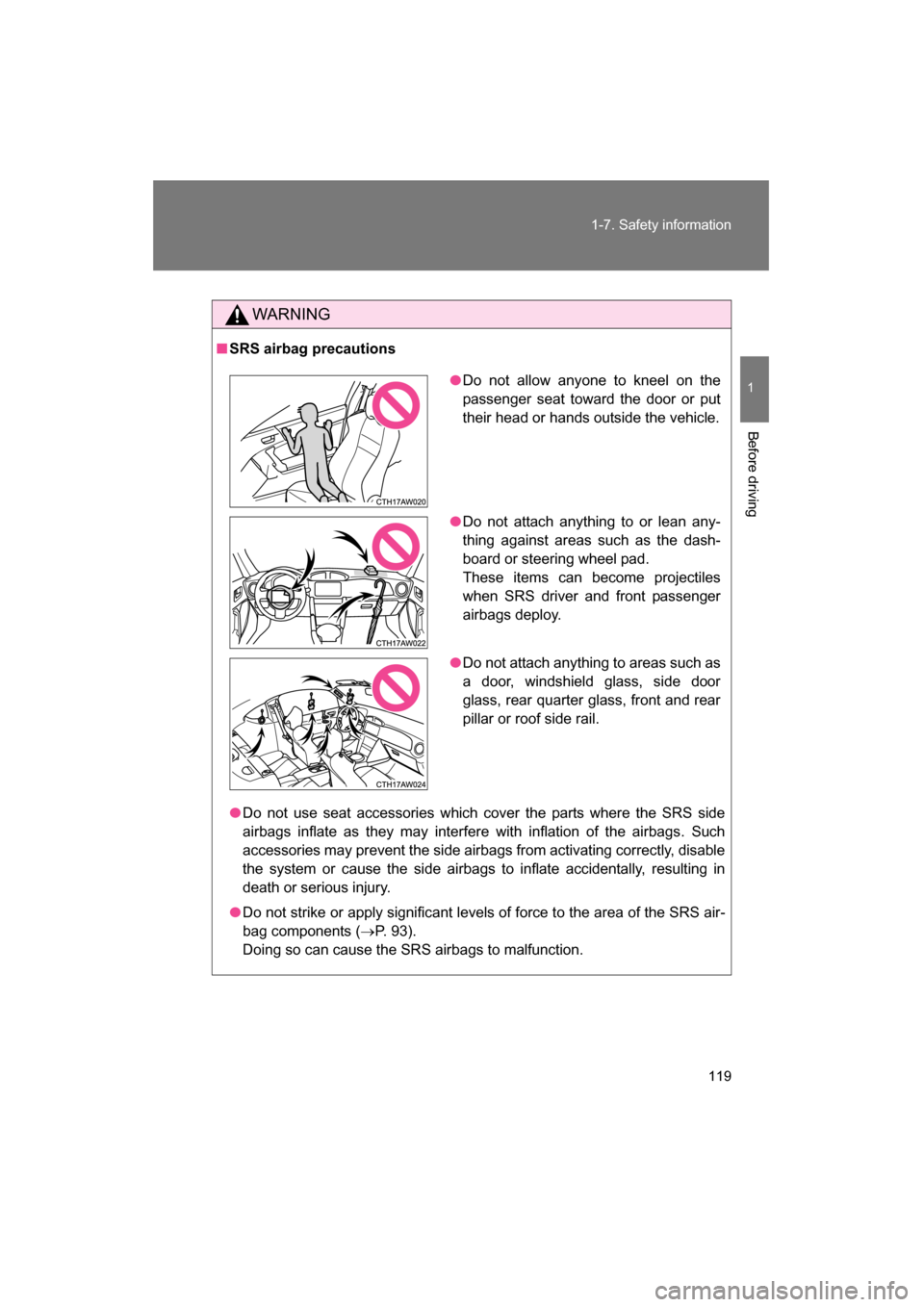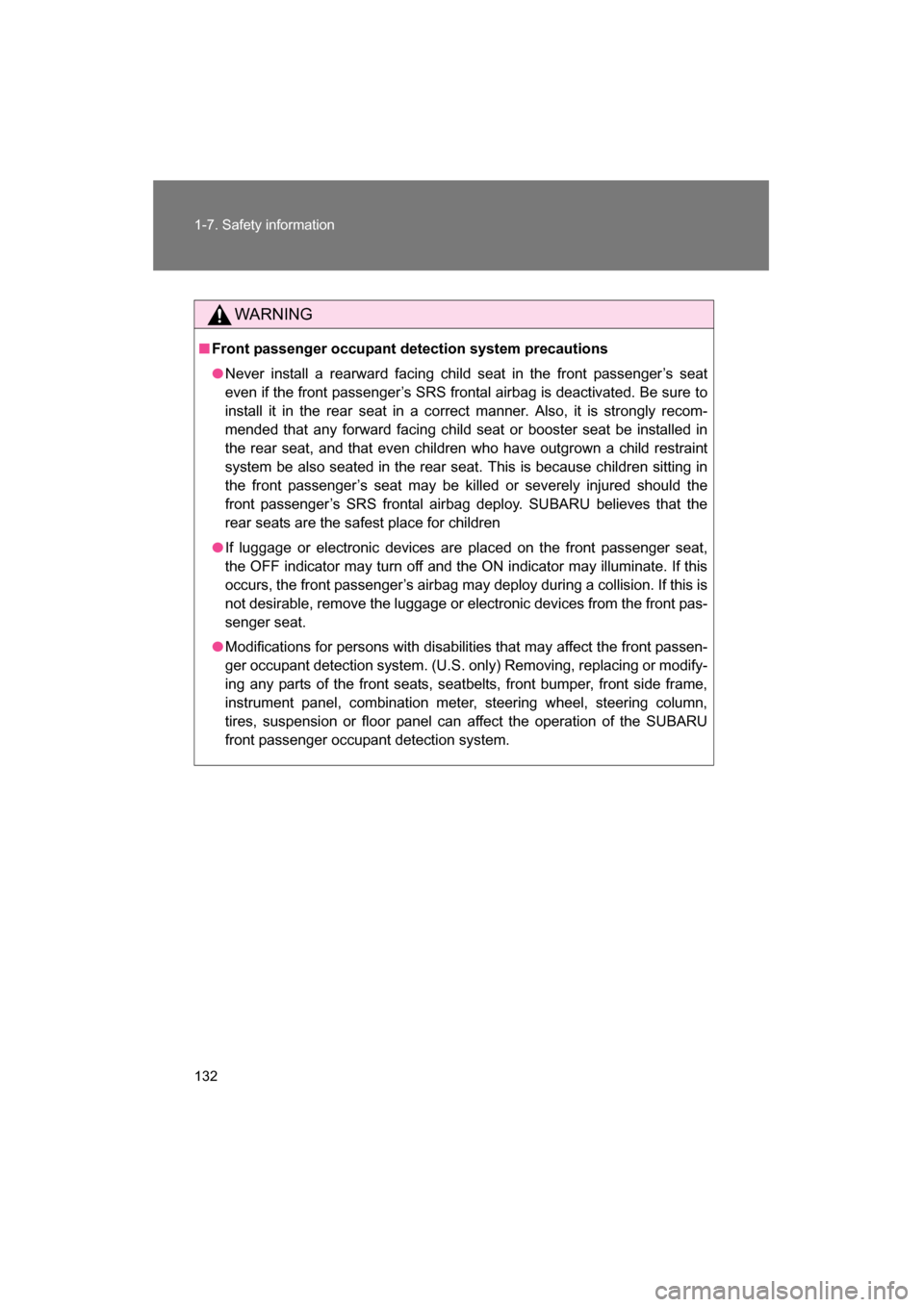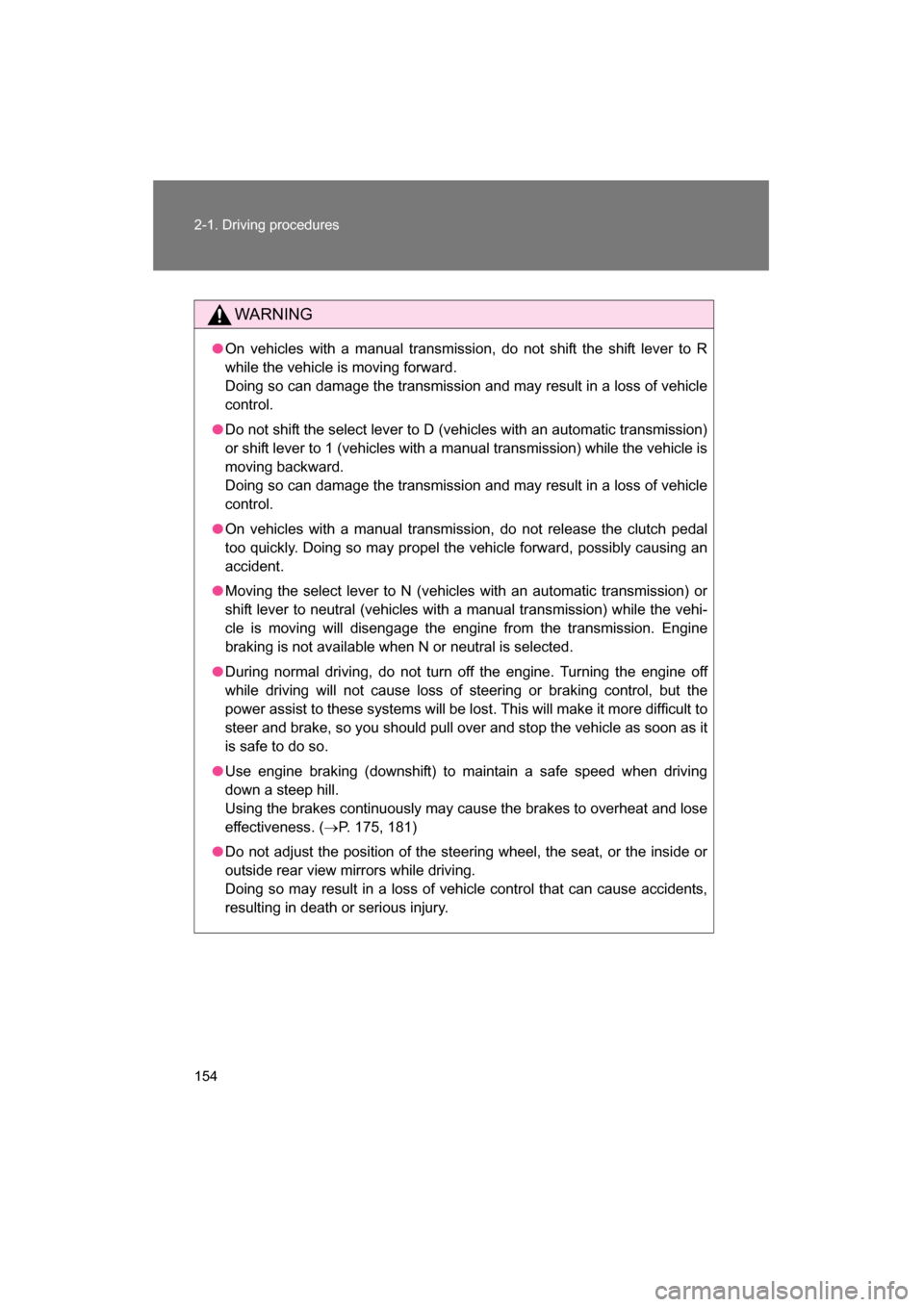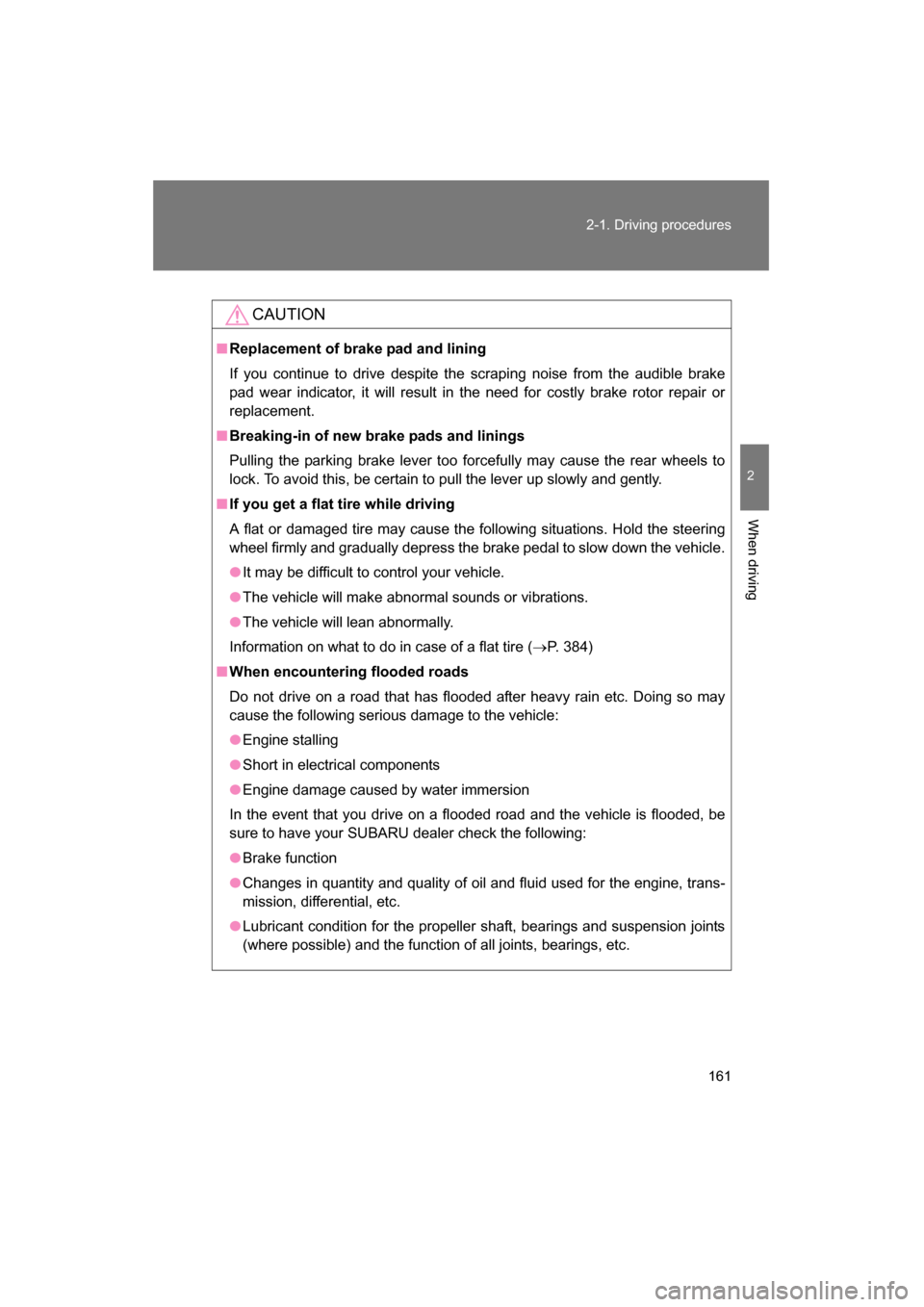Page 119 of 492

119
1-7. Safety information
1
Before driving
WARNING
■SRS airbag precautions
●Do not use seat accessories which cover the parts where the SRS side
airbags inflate as they may interfere with inflation of the airbags. Such
accessories may prevent the side airbags from activating correctly, disable
the system or cause the side airbags to inflate accidentally, resulting in
death or serious injury.
●Do not strike or apply significant levels of force to the area of the SRS air-
bag components (→P. 93).
Doing so can cause the SRS airbags to malfunction.
●Do not allow anyone to kneel on the
passenger seat toward the door or put
their head or hands outside the vehicle.
●Do not attach anything to or lean any-
thing against areas such as the dash-
board or steering wheel pad.
These items can become projectiles
when SRS driver and front passenger
airbags deploy.
●Do not attach anything to areas such as
a door, windshield glass, side door
glass, rear quarter glass, front and rear
pillar or roof side rail.
Page 120 of 492

120
1-7. Safety information
WARNING
■SRS airbag precautions
●Do not touch any of the component parts immediately after the SRS air-
bags have deployed (inflated) as they may be hot.
●If breathing becomes difficult after the SRS airbag has deployed, open a
door or window to allow fresh air in, or leave the vehicle if it is safe to do
so. Wash off any residue as soon as possible to prevent skin irritation.
●If the areas where the SRS airbags are stored, such as the steering wheel
pad and front and rear pillar garnishes, are damaged or cracked, have
them replaced by your SUBARU dealer.
■Modification and disposal of SRS airbag system components
Do not dispose of your vehicle or perform any of the following modifications
without consulting your SUBARU dealer.
The SRS airbags may malfunction or deploy (inflate) accidentally, causing
death or serious injury.
●Installation, removal, disassembly and repair of the SRS airbags.
●Repairs, modifications, removal or replacement of the steering wheel,
instrument panel, dashboard, seats or seat upholstery, front, side and rear
pillars or roof side rails.
●Repairs or modifications of the front fender, front bumper, or side of the
occupant compartment.
●Installation of a grille guard (bull bars, kangaroo bar, etc.), snow plows,
winches.
●Modifications to the vehicle's suspension system.
●Installation of electronic devices su ch as mobile two-way radios and CD
players.
●Modifications to your vehicle for a person with a physical disability.
Page 121 of 492

121
1-7. Safety information
1
Before driving
SRS airbag system monitorsA diagnostic system continually
monitors the readiness of the
SRS airbag system (including
front seatbelt pretensioners)
while the vehicle is being driven.
The SRS airbag system warning
light will show normal system
operation by illuminating for
approximately 6 seconds when
the ignition switch is turned to
the “ON” position.
The following components are monitored by the indicator: ● Front sub sensor (right-hand side)
● Front sub sensor (left-hand side)
● Airbag control module (including impact sensors)
● Frontal airbag module (driver’s side)
● Frontal airbag module (front passenger’s side)
● Side airbag sensor (center pillar right-hand side)
● Side airbag sensor (center pillar left-hand side)
● Door impact sensor (right-hand side)
● Door impact sensor (left-hand side)
● Side airbag module (driver’s side)
● Side airbag module (front passenger’s side)
● Curtain airbag sensor (rear wheel house right-hand side)
● Curtain airbag sensor (rear wheel house left-hand side)
● Curtain airbag module (right-hand side)
Page 132 of 492

132
1-7. Safety information
WARNING
■Front passenger occupant detection system precautions
●Never install a rearward facing child seat in the front passenger’s seat
even if the front passenger’s SRS frontal airbag is deactivated. Be sure to
install it in the rear seat in a correct manner. Also, it is strongly recom-
mended that any forward facing child seat or booster seat be installed in
the rear seat, and that even children who have outgrown a child restraint
system be also seated in the rear seat. This is because children sitting in
the front passenger’s seat may be killed or severely injured should the
front passenger’s SRS frontal airbag deploy. SUBARU believes that the
rear seats are the safest place for children
●If luggage or electronic devices are placed on the front passenger seat,
the OFF indicator may turn off and the ON indicator may illuminate. If this
occurs, the front passenger’s airbag may deploy during a collision. If this is
not desirable, remove the luggage or electronic devices from the front pas-
senger seat.
●Modifications for persons wi th disabilities that may affect the front passen-
ger occupant detection system. (U.S. onl y) Removing, replacing or modify-
ing any parts of the front seats, seatbelts, front bumper, front side frame,
instrument panel, combination meter, steering wheel, steering column,
tires, suspension or floor panel can affect the operation of the SUBARU
front passenger occupant detection system.
Page 149 of 492

149
2-1. Driving procedures
2
When driving
■Parking the vehicle
Vehicles with an automatic transmission With the select lever in D, depress the brake pedal.
Shift the select lever to P. ( →P. 174)
Set the parking brake. ( →P. 185)
Vehicles without a keyless access with push button start
system:
Turn the engine switch to the “LOCK” position to stop the
engine.
Vehicles with a keyless access with push button start sys-
tem:
Press the push-button ignition switch to stop the engine.
Lock the door, making sure that you have the key on your
person.
If parking on a hill, block the wheels as needed.
Vehicles with a manual transmission While depressing the clutch pedal, depress the brake
pedal.
Shift the shift lever to neutral. ( →P. 181)
Set the parking brake. ( →P. 185)
Vehicles without a keyless access with push button start
system:
Turn the engine switch to the “LOCK” position to stop the
engine.
Vehicles with a keyless access with push button start sys-
tem:
Press the push-button ignition switch to stop the engine.
Lock the door, making sure that you have the key on your
person.
If parking on a hill, shift the shift lever to 1 or R and block the
wheels as needed.
STEP 1
STEP 2
STEP 3
STEP 4
STEP 5
STEP 1
STEP 2
STEP 3
STEP 4
STEP 5
Page 153 of 492
153
2-1. Driving procedures
2
When driving
WARNING
■When starting the vehicle (vehicles with an automatic transmission)
●Always keep your foot on the brake pedal while stopped with the engine
running. This prevents the vehicle from creeping.
●Firmly depress the brake pedal because engine speed may increase
immediately after starting the engine, when the air conditioning system is
operating, when turning the steering wheel, etc., thereby causing creeping
to become stronger. Apply the parking brake as necessary.
■When driving the vehicle
●Do not drive if you are unfamiliar with the location of the brake and accel-
erator pedals to avoid depressing the wrong pedal.
Page 154 of 492

154
2-1. Driving procedures
WARNING
●On vehicles with a manual transmission, do not shift the shift lever to R
while the vehicle is moving forward.
Doing so can damage the transmission and may result in a loss of vehicle
control.
●Do not shift the select lever to D (vehicles with an automatic transmission)
or shift lever to 1 (vehicles with a manual transmission) while the vehicle is
moving backward.
Doing so can damage the transmission and may result in a loss of vehicle
control.
●On vehicles with a manual transmission, do not release the clutch pedal
too quickly. Doing so may propel the vehicle forward, possibly causing an
accident.
●Moving the select lever to N (vehicles with an automatic transmission) or
shift lever to neutral (vehicles with a manual transmission) while the vehi-
cle is moving will disengage the engine from the transmission. Engine
braking is not available when N or neutral is selected.
●During normal driving, do not turn off the engine. Turning the engine off
while driving will not cause loss of steering or braking control, but the
power assist to these systems will be lost. This will make it more difficult to
steer and brake, so you should pull over and stop the vehicle as soon as it
is safe to do so.
●Use engine braking (downshift) to maintain a safe speed when driving
down a steep hill.
Using the brakes continuously may cause the brakes to overheat and lose
effectiveness. ( →P. 175, 181)
●Do not adjust the position of the steering wheel, the seat, or the inside or
outside rear view mirrors while driving.
Doing so may result in a loss of vehicle control that can cause accidents,
resulting in death or serious injury.
Page 161 of 492

161
2-1. Driving procedures
2
When driving
CAUTION
■Replacement of brake pad and lining
If you continue to drive despite the scraping noise from the audible brake
pad wear indicator, it will result in the need for costly brake rotor repair or
replacement.
■Breaking-in of new brake pads and linings
Pulling the parking brake lever too forcefully may cause the rear wheels to
lock. To avoid this, be certain to pull the lever up slowly and gently.
■If you get a flat tire while driving
A flat or damaged tire may cause the following situations. Hold the steering
wheel firmly and gradually depress the brake pedal to slow down the vehicle.
●It may be difficult to control your vehicle.
●The vehicle will make abnormal sounds or vibrations.
●The vehicle will lean abnormally.
Information on what to do in case of a flat tire ( →P. 384)
■When encountering flooded roads
Do not drive on a road that has flooded after heavy rain etc. Doing so may
cause the following serious damage to the vehicle:
●Engine stalling
●Short in electrical components
●Engine damage caused by water immersion
In the event that you drive on a flooded road and the vehicle is flooded, be
sure to have your SUBARU dealer check the following:
●Brake function
●Changes in quantity and quality of oil and fluid used for the engine, trans-
mission, differential, etc.
●Lubricant condition for the propeller shaft, bearings and suspension joints
(where possible) and the function of all joints, bearings, etc.